The 2021 Barometer of the digital maturity of Walloon citizens provides a detailed assessment of changes in household equipment, the evolution of uses and the progression of skills. In a brand-new section, it also probes how people perceive the digital world, and compares this with similar data collected in Flanders by IMEC's digimeter.
- undefined undefined
- undefined undefined
- undefined undefined
- Download the complete Citizens 2021 barometer brochure (pdf)
More equipment and connections
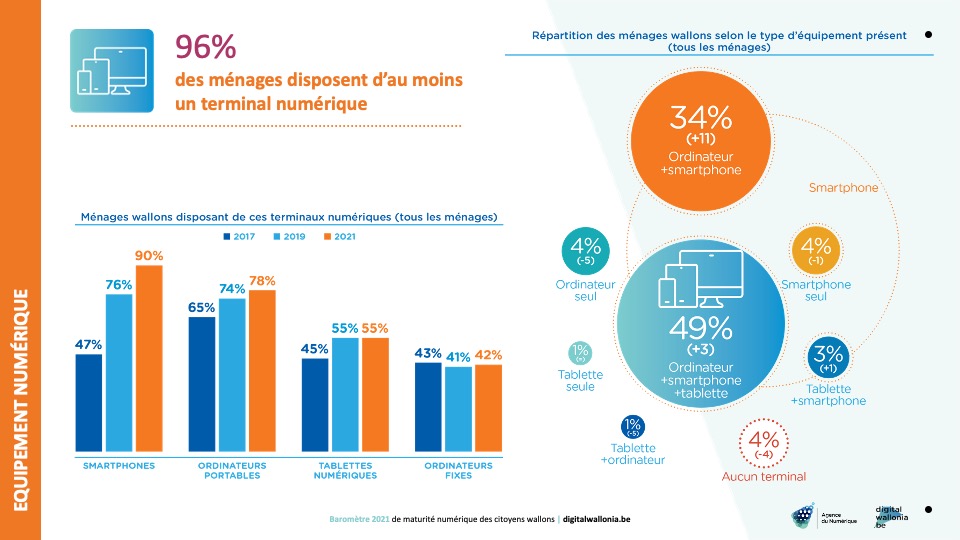
Smartphones in particular have made progress, increasing the number of households owning at least one from 76% to 90%.. Laptops also rose from 74% to 78%, while desktop computers and digital tablets remained stable at 55% and 42%. Half of all households (49%) now have a combination of smartphone, computer and tablet, while a further 34% have at least one smartphone and one computer.
That leaves just 4% of households without any digital terminal at all. These are mainly elderly couples and single people.
85% of citizens have a personal smartphone (+10) and "wearables" are also on the rise, including :
- connected watches (13%, +5),
- biometric wristbands (10%, +3).
The Covid effect
Covid has helped boost household equipment: 18% of households have acquired computers, but also tablets, smartphones, and even screens or webcams. The main reasons for this are to keep children in school (57%) or to telework (42%), but sometimes also to keep in touch with loved ones (12%).
However, 10% of working households with children report that the equipment available is insufficient to meet the telecommuting and study needs of all household members.
Internet connections
94% (+4) of homes are now connected to the Internet. 57% of users consider their connection to be stable and satisfactory, but 12% consider it to be weak, as they suffer from regular interruptions and slowness. In terms of equipment and connection, the digital access divide has narrowed considerably.
Public Internet access was also much less used this year, with usage rates dropping to half or even a third of 2019 levels. Digital public spaces (EPN) attracted just 3% of the population in 2020, compared with 7% in 2018.
Internet use also on the rise
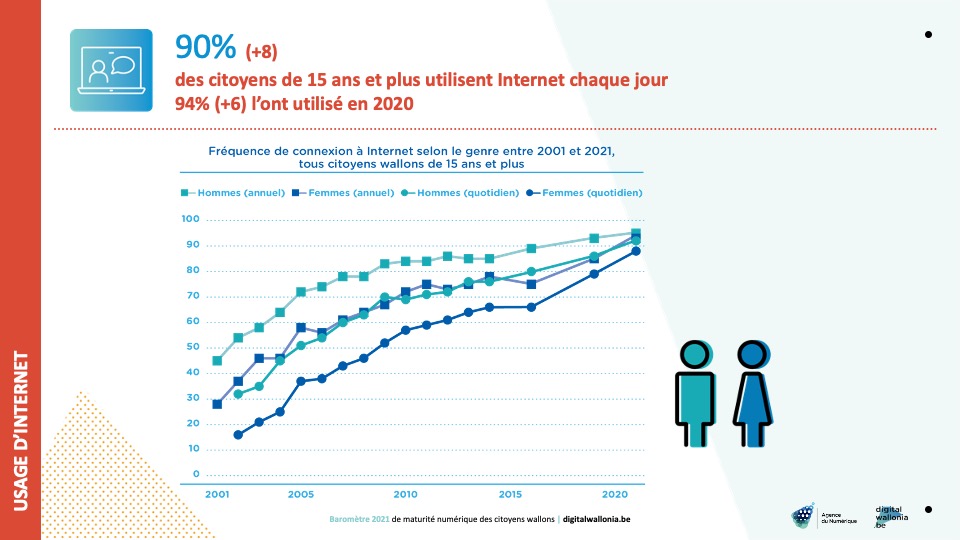
The increase in total use is mainly attributable to women, who have risen by 6 points, while the increase is just one point for men. For daily use, increases are spread across all age groups and both genders.
Smartphones make their mark
Numerous special uses have made progress, sometimes spectacularly so:
- videoconferencing increases from 42% to 64% of users,
- Internet telephony rises from 51% to 66%.
Smartphones are becoming the default channel for a growing number of digital interactions, including online ordering (43%, +16) and bank transfers (58%, +16).
The biggest relative increase was in the transmission of medical data via the Internet, which more than doubled from 8% to 20%, in a health context that could only be positive for this use.
E-mail and instant messaging remain the most common means of communication and are also on the increase:
- 82% of Walloons (+4) for mail,
- 74% (+7) for courier services.
Social networks remain a safe bet (72%, +4):
- Facebook (65%), loin devant ...,
- Instagram (25%),
- Snapchat (17%),
- LinkedIn (9%),
- Twitter (7%).
Numerous administrative websites also saw an increase in visitors, most notably that of the FWB (28%, +6), which was certainly in high demand for instructions on education and culture during the health crisis. 32% of Walloons (+3) completed an administrative declaration online.
Similarly, online office applications (34%, +8) and distance learning courses (28%, +6) also benefited from the very special situation of 2020.
Other applications, however, were severely penalized by the health crisis:
- online travel and restaurant reservations, from 46% to 33%,
- job search and CV submission, from 19% to 15%,
- online photo albums, from 24% to 16%.
Strong growth in e-Commerce
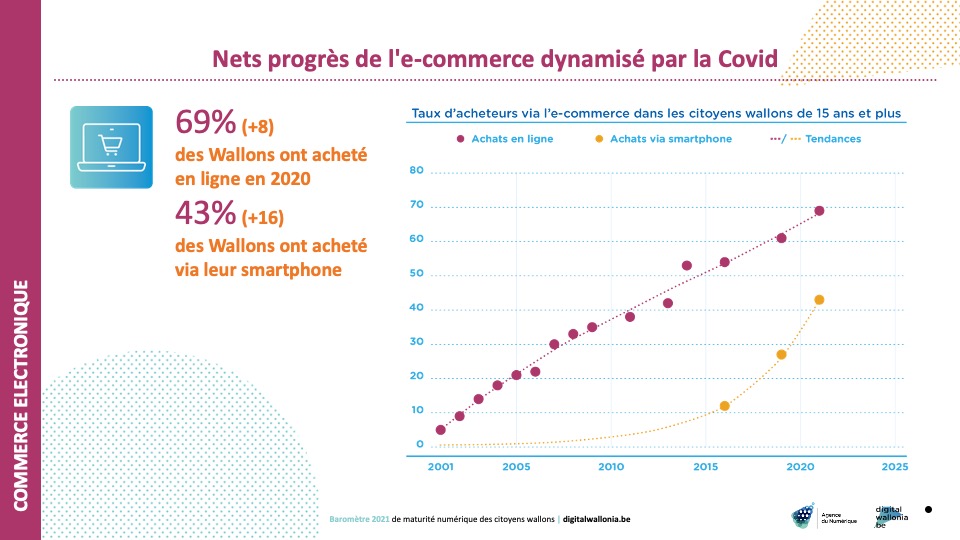
The Covid crisis has also had a strong influence on the types of purchases made over the Internet, leading to a net increase in :
- clothing, footwear and sporting goods (71%, +8),
- food and grocery (29%, +10),
- furniture and garden furniture (22%, +7).
Conversely, travel and vacation bookings plunged (49%, -30), as did tickets for concerts and shows (9%, -27).
Female shoppers in particular have often preferred to use mobile devices for online purchases.
5% of Walloons ordered online for the first time because of Covid-19, and 22% significantly increased their online purchases as a result.
Just over one in three buyers prefers to make their purchases on a Belgian site, and these are much more likely to be female buyers (41%) than male buyers (33%), although the majority don't really care where they shop. Above all, it's the merchant's reputation (51%) and consumer reviews (41%) that are taken into account, as long as payment security is guaranteed.
Slow progress in skills and digital maturity
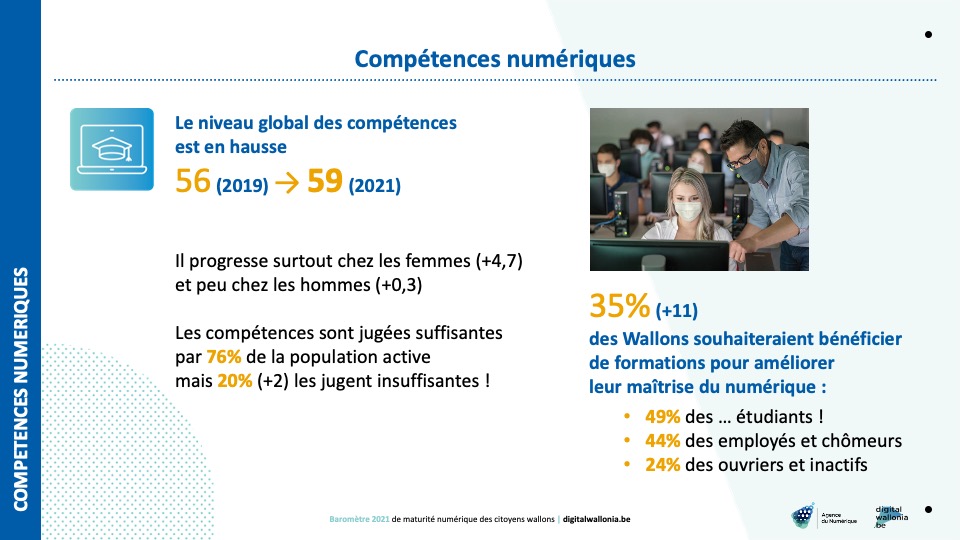
As in 2019, all respondents were asked to determine their level of digital skills by indicating how comfortable they felt with 15 representative tasks, 13 of which were identical to those tested in 2019.
The evolution is modest, but positive on practically all tasks, apart from the two new ones which were indeed more difficult, leading to an overall increase in the feeling of competence from 56 to 59. This positive trend is much more pronounced for women (+4.7) than for men (+0.3).
However, these skills are considered sufficient by only 76% of the working population, and are even regarded as genuinely insufficient by 20% (+2).
Thus, 35% of the population, 11 points more than in 2019, would like to benefit from training to improve their digital skills., including 49% of students, as well as 44% of employees and the unemployed.
Combined with a digital maturity indicator that also improved from 46.9 to 50.8. The share of the weakest users fortunately fell from 20.6% to 17.9%, but at the same time the share of citizens with high digital maturity also fell from 16% to 10.7%, leading to a tightening of average maturity levels. Unsurprisingly, the lowest levels of maturity are found mainly among the over-50s and especially the over-75s. There are also 20% women and 15% men.
But a reserved adoption of digital technology
New to the 2021 barometer is a battery of questions assessing citizens' attitudes to digital technology, enabling them to compare these attitudes with those measured by IMEC in Flanders at the end of 2020.
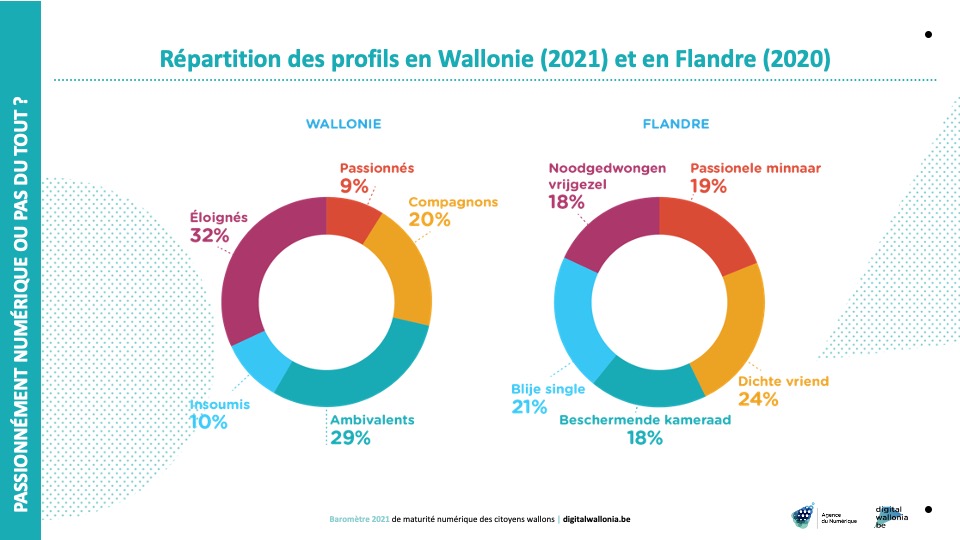
Five characteristic profiles have been traced and show that :
- 9% of Walloons are "passionate" about digital technologies,
- 20% are confident "companions", but more measured in their enthusiasm and more sensitive to constraints.
- 29% are "ambivalent", with a position that remains positive, but with doubts and concerns.
- 10% are "insoumis" who don't neglect digital technology, but limit its use to the essentials, avoiding spending time on social networks and their smartphones.
- 32% are digital "outsiders", with little confidence and little or no use of digital technology.
A comparison with Flanders shows a much lower number of enthusiasts and companions, with only 29% together, compared with 43% in the north of the country. Conversely, the number of remote users, 32% in Wallonia and 18% in Flanders, confirms a greater digital divide in our region.
The survey also shows that awareness of the environmental impact of digital technology still has a long way to go. While more than two-thirds of Walloons are already aware of the importance of extending the lifespan of equipment, far fewer are aware of the consumption induced by streaming and high-resolution images.
The digital divide shifts from access to use
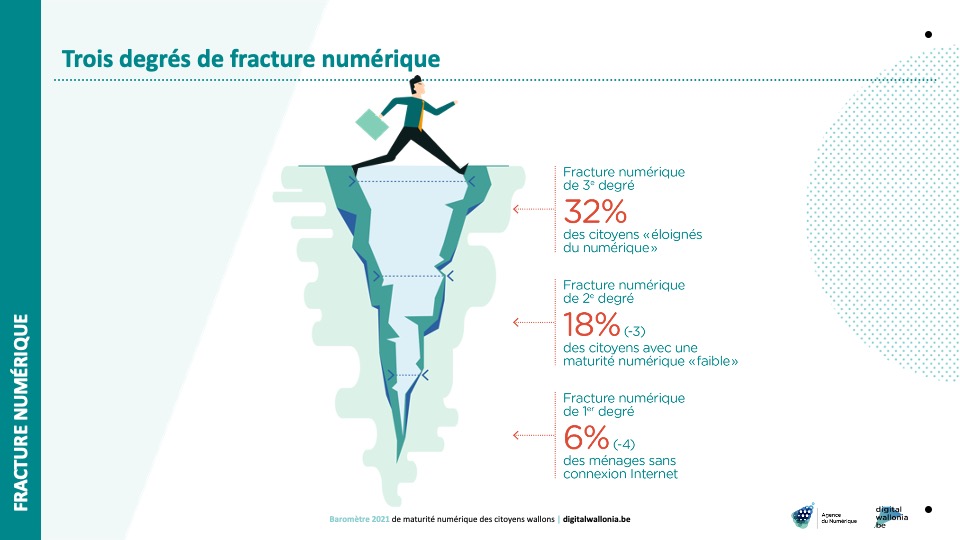
Depending on the point of view adopted, we can see that the digital access divide or 1st degree divide has been well reduced, with the rate of homes without an Internet connection falling from 10% in 2019 to 6% in 2021.
However, if we consider the usage divide, we can see that the group of Walloons with low maturity has only shrunk from 21% to 18% this year. On the other hand, 32% of Walloons are classified as "distant" from digital on the basis of their attitudes towards these technologies, and can reasonably be associated with a 3rd degree divide, namely the ability to harness digital technology for one's own development.
In a context where digital technology is everywhere, it is therefore difficult to consider that the digital divide has really been reduced, despite interesting progress in many indicators.
The digital divide is changing in nature, potentially isolating those who have very restrictive uses and who feel uncomfortable with these technologies and their societal implications.
To know more
About the author.
André Delacharlerie
Agence du Numérique